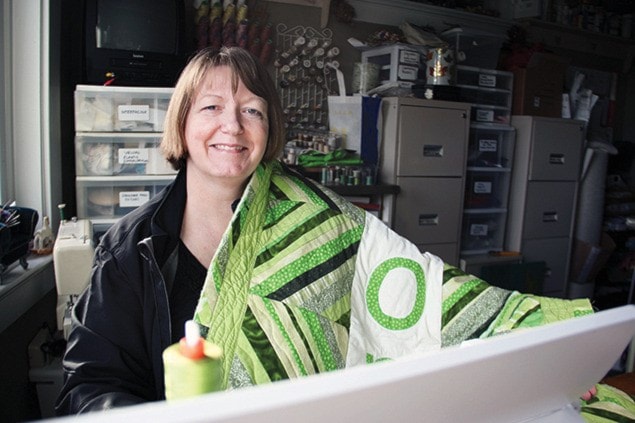Christine Knox can no longer do many simple activities like walk to the grocery store or go for a drink in the evening, but she hopes to support others suffering from a relatively rare disease through her passion for quilting.
Knox battled constant migraines, an irregular heartbeat, muscle pain and fatigue for years before doctors discovered she suffers from mitochondrial disease, a debilitating condition where the energy powerhouses of the cells degrade or stop working altogether.
“I was sleeping sometimes up to 15 hours a day. It was like having the flu all the time and never recovering,” says Knox, who now takes a strict vitamin and pharmaceutical cocktail to manage her symptoms.
Mitochondrial disease includes a variety of genetic mutations in the mitochondrial DNA that can lead to seizures, hearing loss, heart problems and even respiratory failure.
One in 6,000 Canadians suffer from the disease but less than 10 per cent are diagnosed, according to MitoCanada, a registered charity that provides awareness and support for both patients and researchers studying its effects.
Prof. Francis Choy, a human geneticist and member of the University of Victoria’s Centre for Biomedical Studies, is one of those researchers fascinated by the disease and assessing treatments.
Choy estimates between one in 10,000 to one in 15,000 people are born with a mitochondrial disease, though he stresses that number is still an educated guess.
There’s no cure for the disease and current treatments are limited to managing symptoms and slowing disease progression, he said.
“It’s a complicated diagnosis but it can be done if the practitioner is competent,” Choy said.
The disease is terrible in its worst manifestation, but fortunately many mutations fall below a threshold that still allow patients to live relatively productive lives, albeit with limited activity, he added.
In September, Choy and honours thesis biology student Kelly Turner published a paper in the Journal of Molecular and Genetics Medicine examining the current methods to prevent transmission of mitochondrial DNA defects from mother to child, a developing field of biomedical research that includes genetic diagnosis.
While research is still in the early stages, some women with the most severe cases of mitochondrial disease can have children while avoiding transmission of the genetic mutations.
“Since the mitochondria are the powerhouses of our cells, they’re super important for the tissue that has high energy uses, so the brain or the muscles,” Turner said. “When there’s a defect in the mitochondria, it makes you sick because you don’t have enough energy getting to certain places in your body.”
The disease may be less familiar among physicians who graduated before the mid-1980s, when medical genetics became standard learning in medical training. But Choy and others continue to offer advanced genetic testing for those suffering from mitochondrial disease with the goal of developing better treatment and prevention methods.
“Certain vitamin therapies have been shown to improve the symptoms. but it’s so hard to predict how a specific patient is going to react. It’s really an individual disease,” Turner said.
Knox, who gets by thanks to solid disability insurance from her former employer, is now putting what energy she has towards her Mito Quilts of Hope project, which raises awareness and provides support by sending handmade quilts to others with mitochondrial disease.
“In Canada, I’ve got about 30 requests for quilts,” Knox said. “In the U.S., I’ve got over 100 requests. I’ve already sent out about 20 quilts, which take anywhere from three to six months to make depending on the complexity of design.”
Knox is looking for quilting volunteers to help her fill those back orders. She’s also teamed up with local filmmaker Brian Barnard to produce a film about mitochondrial disease and her own journey.
“Relatively speaking, I’ve lived a very full life,” she said. “This is what I can do now to make a difference with the talents I still have.”
For more information on mitochondrial disease, visit mitocanada.org.
For more information or to donate to Barnard’s film, search “Mito awareness project” on Indiegogo.com.
editor@saanichnews.com
